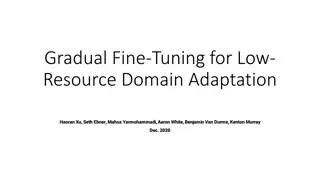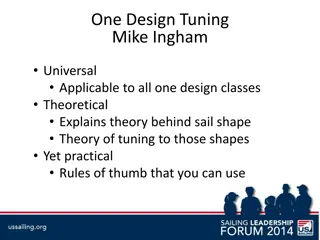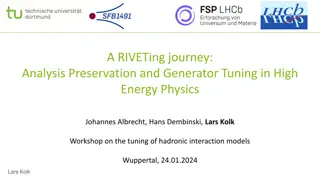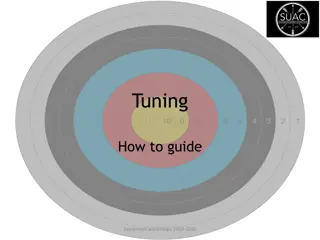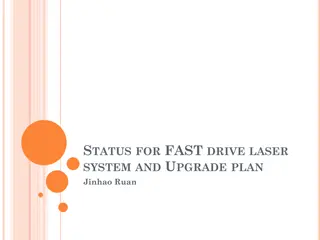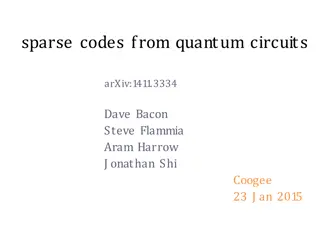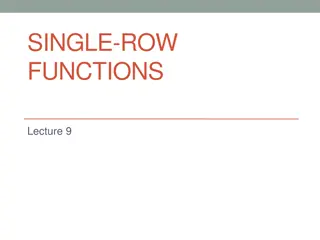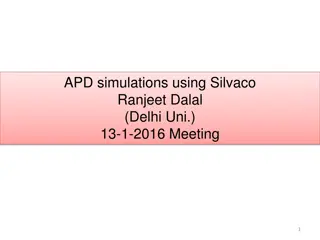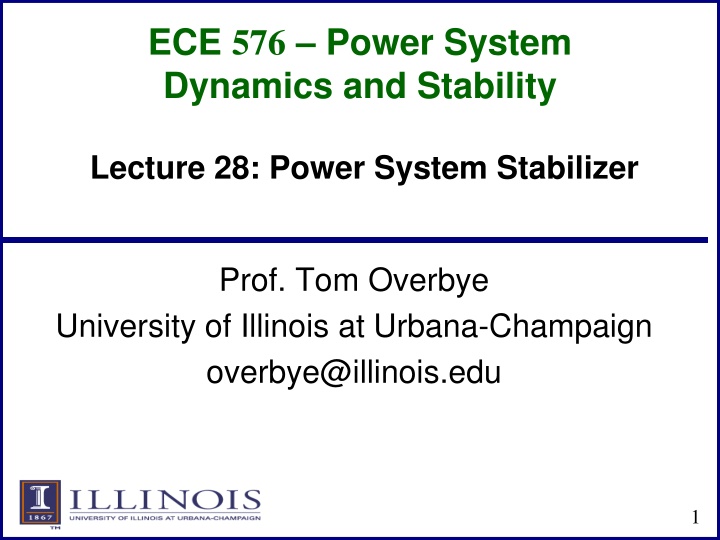
Power System Stabilizer Functions and Tuning
This lecture discusses the functions of a Power System Stabilizer (PSS), its role in adding damping to the excitation system, the importance of tuning PSS parameters for system stability, and provides examples of single and dual input PSS configurations. Modal analysis, participation factors, and the basic tuning approach are explored with a focus on achieving desired damping in power systems.
Download Presentation

Please find below an Image/Link to download the presentation.
The content on the website is provided AS IS for your information and personal use only. It may not be sold, licensed, or shared on other websites without obtaining consent from the author. If you encounter any issues during the download, it is possible that the publisher has removed the file from their server.
You are allowed to download the files provided on this website for personal or commercial use, subject to the condition that they are used lawfully. All files are the property of their respective owners.
The content on the website is provided AS IS for your information and personal use only. It may not be sold, licensed, or shared on other websites without obtaining consent from the author.
E N D
Presentation Transcript
ECE 576 Power System Dynamics and Stability Lecture 28: Power System Stabilizer Prof. Tom Overbye University of Illinois at Urbana-Champaign overbye@illinois.edu 1
Announcements Read Chapters 8 and 9 Homework 8 should be completed before final but need not be turned in Final is Wednesday May 14 at 7 to 10pm Key papers for book's approach on stabilizers are F.P. DeMello and C. Concordia, "Concepts of Synchronous Machine Stability as Affected by Excitation Control, IEEE Trans. Power Apparatus and Systems, vol. PAS-88, April 1969, pp. 316-329 W.G. Heffron and R.A. Philips, "Effects of Modern Amplidyne Voltage Regulator in Underexcited Operation of Large Turbine Generators," AIEE, PAS-71, August 1952, pp. 692-697 2
Functions of a PSS PSS adds a signal to the excitation system proportional to speed deviation. This adds positive damping Other inputs, like power, voltage or acceleration, can be used Signal is generated locally from the shaft. Both local mode and inter-area mode can be damped. When oscillation is observed on a system or a planning study reveals poorly damped oscillations, use of participation factors helps in identifying the machine(s) where PSS has to be located. Tuning of PSS regularly is important. Modal Analysis technique forms the basis for multi- machine systems. 3
Example PSS An example single input stabilizer is shown below (IEEEST) The input is usually the generator shaft speed deviation, but it could also be the bus frequency deviation, generator electric power or voltage magnitude VST is an input into the exciter 4
Example PSS Below is an example of a dual input PSS (PSS2A) Combining shaft speed deviation with generator electric power is common Both inputs have washout filters to remove low frequency components of the input signals IEEE Std 421.5 describes the common stabilizers 5
PSS Tuning: Basic Approach The PSS parameters need to be selected to achieve the desired damping through a process known as tuning The next several slides present a basic method using a single machine, infinite bus (SMIB) representation Start with the linearized differential, algebraic model with controls u added to the states + + x = A x B y E u 0 = C x+D y If D is invertible then ( x = A BD C x E u ) + = + -1 A x E u sys 6
SMIB System (Flux Decay Model) Process is introduced using an SMIB with a flux decay machine model and a fast exciter j te V e R jX e ~ + 0 V ( ) 2 / j ( ) I jI e d q = pu s 1 = + + ' ' [ ( ( ) )] T E I X X I I D pu M q q d d d q pu 2H 1 T = + ' ' ' ( ( ) ) E E X X I E q q d d d fd ' do 7
Stator Equations Assume Rs=0, then the stator algebraic equations are: 0 ) sin( = t q q I X V E ) 1 ( X I V = ' ' cos( ) 0 ) 2 ( q t jV d d + = ( ) 2 / j j ( ) ) 3 ( V e V e d V q jV t + = ( ) 2 / j j ) 4 ( V e e d q t ) 4 ( Expand right hand side of + = + sin( ) cos( = V ) ) 5 ( V jV V jV d q V t t = sin( ) cos( ) V and V d and t q t = ) 1 ( ) 2 ( 0 ) 6 ( become X I V q q d = ' ' 0 ) 7 ( E V X I q q d d 8
Network Equations The network equation is (assuming zero angle at the infinite bus and no local load) + ( / ) 2 j ( ) R V jV e V 0 d q + = ( / ) 2 j ( ) I jI e d q + jX e e + + ( / ) 2 j ( ) V jV V e jX d q + = ( ) I jI d q R e e + = = sin R I X I V V Simplifying, e d e q d cos X I R I V V e d e q q j V te e R X e ~ 0 V + ( ) 2 / j ( ) I jI e 9 d q
Complete SMIB Model 1 = + ' ' ' ( ( ) ) E E X X I E q q d d d fd ' T do Machine equations = pu 1 s = + + ' ' [ ( ( ) )] T E I X X I I D pu M q q q d d q pu 2H V = X I 0 Stator equations q q d = ' ' E V + X I 0 q q d d Network equations = = sin R I X I V V 0 V e d e q d j V te cos X I R I V V e d e q q e R jX e ~ 10 + ( ) 2 / j ( ) I jI e d q
Linearization of SMIB Model Step 1: Linearize the stator equations V V I I 0 E 0 X X 0 d d q = + ' ' q q q d Step 2: Linearize the network equations V R X V X R righthand sides of the above equations I R X X X X R + I I cos sin V d d e e = + V q q e e Step 3: Equate the + 0 E ( ) cos sin V V d e e q = + ' ' I ( ) q q e d e Notice this is equivalent to a generator at the infinite bus with modified resistance and reactance values 11
Linearization (contd) Solve for , I I d q + + + ( cos sin ( ) X X RV V X X I I ' E 1 ) e q e q e d = q ( ) 1 + + ' sin cos ( ) R RV V X X q e e d e = + + + ' 2 e The determinant is ( )( ) R X X X X e q e d 1. Linearizing Machine Equations , ( x f x = Final Steps involve . , , , ) ) 2 ( I I E T d q fd M 2. Substitute (1) in the linearized equations of (2). 12
Linearization of Machine Equations 0 0 1 ' ' E E ' T q q do 0 = ( ) 1 0 s o q I D 2H 0 s pu pu 2H ' ( ) X X 0 0 1 1 d d ' ' T T I I do do 0 0 E T d fd + + 0 0 0 q M ' ' ' o q o q o ( ) ( ) I X X X X I E 1 1 1 1 d q d q q 2H 2H 2H 2H Symbolically we have x A x = + + ( ) 2 B u C I d q = D x ( ) 3 I d q Substitute (3) in (2) to get linearized model. 13
Linearized SMIB Model K T 1 1 = + ' ' 4 E E E q q fd ' ' ' K T T 3 do do do = s pu D 2H K 2H K 2H 1 = + ' s E T 2 1 pu q pu M 2H Excitation system is yet to be included. K1 K4 constants are defined on next slide 14
K1 K4 Constants + ' ( )( ) X X X X 1 d d q e = + 1 K 3 ' ( ) V X X = + ( ) sin cos d d K X X R 4 q e e 1 = + + ' ' ' o q o q o d o ( )( ) ( ) K I I X X X X R X X I R E 2 d q q e e d q e q 1 = + ' o q [ ( ){( ) sin cos } K I V X X X X R 1 d q q e e + + }] ' ' ' o d o {( ) }{( ) cos sin V X X I E X X R d q q d e e K1 K4 only involve machine and not the exciter. 15
Including Terminal Voltage The change in the terminal voltage magnitude also needs to be include since it is an input into the exciter V V ref ref + + tV tV = + 2 2 V V V t d + q Differentiating = 2 2 2 V V V t d V q = + o o 2 2 2 V V V V V t t d d q q o V o V q = + d V V V t d q V V t t 16
Computing While linearizing the stator algebraic equations, we had V 0 X V X 0 0 E ' E d q = + q ' ' q q d Substitute this in expression for Vt to get = + ' V K K E t 5 6 q o V V 1 = + + ' [ sin cos ( )] d K X RV V X X 5 q e d e t o V V q + + ' [ ( cos ( )sin )] X RV V X X d e q e t o o V V V V o V V 1 q q = + + ' ( ) d K X R X X X 6 q e d q e t t t 17
HeffronPhillips Model Add a fast exciter with a single differential equation ( A fd fd A ref t T E E K V V = + ) Linearize = + ( ) T E E K V V A fd fd A ref t K = + + ' ( ) T E E K V K K E A fd fd A ref A 5 6 q This is then combined with the previous three differential equations to give = + x A x B u sys SMIB Model = T [ ] T V u M ref 18
Block Diagram K1 K6 are affected by system loading and Xe 19
Numerical Example Consider an SMIB system with Zeq = j0.5, Vinf = 1.05, in which in the power flow the generator has S = 54.34 j2.85 MVA with a Vt of 1 15 Machine is modeled with a flux decay model with (pu, 100 MVA) H=3.2, T'do=9.6, Xd=2.5, Xq=2.1, X'd=0.39, Rs=0, D=0 Saved as case B2_PSS_Flux (but only available in v18) 20
Initial Conditions The initial conditions are 1 15 . 1 05 0 j0 5 + = + = = ( / ) 2 j j ( ) . I e I jI e 0 5443 18 G d q . = = + j j ( ) 0 ( ) . angle of E where E Ve R jX I e t s q G = = + ( . )( . j2 1 0 5443 18 ) E 1 15 1 4788 65 5 . . + = = = ( / ) 2 j j . . , I jI I e e 0 5443 42 48 d q G = . , . . I 0 4014 and I 0 3676 d V q + = 1 39 48 = = ( / ) 2 j j . jV Ve e = d q Hence, . , . V 0 7718 V 0 6358 d q 21
Add an EXST1 Exciter Model Set the parameters to KA = 400, TA=0.2, all others zero with no limits and no compensation Hence this simplified exciter is represented by a single differential equation ( A fd fd A REF T E E K V V = + Vs is the input from the stabilizer, with an initial value of zero + ) V t s 22
Initial Conditions (contd) From the stator algebraic equation, ' ' q q d d E V X I 0 63581 = + = + = + = + = . ( . 0 39 0 4014 )( . ) . 0 7924 ' ' ( ) E E X X I fd q d d d = 0.7924 (2.5 0.39)0.4014 1.6394 1.6394 1 400 A K T E I = + + E fd = + = + = 1.0041 V V REF t = = = ' ' 377, ( ) X X I I s M q q q d d q (0.7924)(0.3676) (2.1 0.39)(0.4014)(0.3676) 0.5436 ( checks with VV ( ) sin )/ X t e 23
Computation of K1 K6 Constants The formulas are used. = + + + = ' 2 e ( )( ) . R X X X X 2 314 e q e d + + ' ( )( ) X X X X 1 d d q e = + = . 1 3 3707 K K 3 = . 0 296667 3 ' ( )[( V X X = + = )sin cos ] . d d K X X R 2 26555 4 q e e 1 = + + = ' ' ' o q o q o d o [ ( )( ) ( ) ] . K I I X X X X R X X I R E 1 0739 2 d q q e e d q e q Similarly K ,K ,and K are calculat = = ed as 1 5 6 = . , . , . K 0 9224 K 0 005 K 0 3572 1 5 6 24
Effect of Field Flux on System Stability With constant field voltage, i.e. Efd=0, from the block diagram K 1+ T K K K ' = 2 3 4 e T 3 s do K2, K3, and K4 are usually positive. On diagram v is used to indicate what we've been calling pu 25
Effect of Field Flux on System Stability For low frequencies and in steady-state, as s=j goes to zero, then T K K K 1 K T s + = e 2 3 4 T K K K e 2 3 4 ' 3 do Hence field flux variation due to feedback (armature reaction) introduces negative synchronizing torque 26
Effect of Field Flux on System Stability At higher frequencies the denominator is dominated by the K3T'dos term so K K K j T K K K = 2 3 4 2 T 4 T j e ' ' do 3 do This is a phase with (j ) Hence Efd results in a positive damping component. 27
Effect of Field Flux on System Stability In general, positive damping torque and negative synchronizing torque due to Efd at typical oscillation frequencies (1-3 Hz). e T T T ) ( ) K E K D 3 4 s fd = ' K E K 2 2 q + ' 1 ( K 3 do sT 28
Effect of Field Flux There are situations when K4 can become negative. ' ( ) V X X = + ( ) sin cos d d K X X R 4 q e e become may negative Case1. A hydraulic generator without a damper winding, light load ( is small) and connected to a line with high Re/Xe ratio and a large system. Case 2. Machine is connected to a large local load, supplied partly by generator and partly by remote large system. If K4 < 0 then the damping due to Efd is negative 29
Effect of Excitation System Ignore dynamics of AVR & KA >> 0 Gain through T'do is -(K4+KAK5)K3 If K5 < 0 then gain becomes positive. VREF = 0 Large enough K5 may make system unstable + ( ) T K K K K K = 4 5 3 2 e A + + 1 ( ) ' ' sK T K K K 3 3 6 do A 30
Numerical Example (Effect of K5) Test system 1 , 50 = K Test System 2 , 50 = K = = 0 0 K K K K K 5 5 A A 6816 . 3 = . 1 = 7585 . 3 = 9813 . 0 = 093 K K K 1 2 1 2 = = 2162 . 0 = 6582 . 2 3864 . 0 = 4746 . 1 = K K 3 4 3 4 = 1103 . 0 0544 . 0 = 3616 . 0 4477 . 0 K K K K 5 6 5 6 = = = ' ' 5 sec 6 sec 5 sec 6 sec T H T H do do = = 2 . 0 sec 2 . 0 sec T T A A Eigen Values Test System 1 Test System 2 946 . 10 353 . 0 j + unstable + + . 0 015 . 5 j 38 j + . 2 61 . 3 22 . 2 77 . 2 j 88 31
Addition of PSS Loop The impact of a PSS can now be considered in which the shaft speed signal is fed through the PSS transfer function G(s) to the excitation system. To analyze effect of PSS signal assume , VREF=0 32
PSS Contribution to Torque T pu PSS (s ) G PSS K 2 sv + K K + 3 A + + ' 1 1 sK T sT = 0 V 3 do A ref K 6 K 2 ( ) T G + s K + ( K ' = 3 PSS v A T 3 + 1 ( )( 1 ) K K K sK ) sT 3 6 A do A G s K K + = = ( GEP ) ( ) 2 A G s s ( ) ( ( ) + + + T ' 2 ' K K s T s T T 1 A 6 A do do A K K s (for usual range of constants) 3 3 ) G + K K / 2 ( ) A 1 ( ( ) ) + + ' 1 K K s T K K sT 1 33 6 6 A do A A K 3
PSS Contribution to Torque For high gain KA T ( ) K G s = 2 PSS v 1 ( ( ) ) + + ' / 1 K s T K K sT 6 6 do A A If PSS were to provide pure damping (in phase with pu), then ideally, ( do PSS K T s K s G + = / 1 ) ( ( ) ) + ' 1 K sT 6 A A = Gain of PSS K i.e. pure lead function PSS Practically G(s) is a combination of lead and lag blocks. 34
PSS Block Diagram y max + + 1 1 sT + sT sT sv K 3 1 w pu + + PSS 1 1 1 sT sT sT 2 4 w y min + + 1 ( ) 1 ( ) sT sT + sT = = ( ) ( ) 3 1 w G s K K G s 1 PSS PSS + + 1 ( ) 1 ( ) 1 ( ) sT sT sT 2 4 w Provide damping over the range of frequencies (0.1-2 Hz) Signal wash out (Tw) is a high pass filter TW is in the range of 5 to 20 seconds Allows oscillation frequencies to pass unchanged. Without it, steady state changes in speed would modify terminal voltage. 35
Criteria for Setting PSS Parameters KPSS determines damping introduced by PSS. T1, T2, T3, T4 determine phase compensation for the phase lag present with no PSS. A typical technique is to compensate for the phase lag in the absence of PSS such that the net phase lag is: Between 0 to 45 from 0.3 to 1 Hz. Less than 90 up to 3 Hz. Typical values of the parameters are: KPSS is in the range of 0.1 to 50 T1 is the lead time constant, 0.2 to 1.5 sec T2 is the lag time constant, 0.02 to 0.15 sec T3 is the lead time constant, 0.2 to 1.5 sec T4 is the lag time constant, 0.02 to 0.15 sec 36
Design Procedure The desired stabilizer gain is obtained by finding the gain at which the system becomes unstable by root locus study. The washout time constant TW is set at 10 sec. KPSS is set at (1/3)K*PSS, where (1/3)K*PSS is the gain at which the system becomes unstable. There are many ways of adjusting the values of T1, T2, T3, T4 Frequency response methods are recommended. 37
Design Procedure Using the Frequency-Domain Method T K K K = = ( ) ( ) , ( ) 2 + 3 K PSS v A GEP s G s GEP s + + ' 1 ( )( 1 ) K K K sT sT 3 6 3 A do A Step 1: Neglecting the damping due to all other sources, find the undamped natural frequency in rad/sec of the torque - angle loop from: n 2 H + = = + 2 , 0 i . . s K e s j 1 2 , 1 n K 1 s 1 K 2 = s where e T 1 n s H 2 H s s D Step 2: Find the phase lag of s GEP ( = 0 T M = ) at s j 1 Ds n e T + + 2 s K 2 H 38 1 s
PSS Design (contd) Step 3: Adjust the phase lead of G(s) such that + = ( ) ( = ) 0 G s GEP s = s j s j n n k + 1 sT = ( ) 1 Let G s K PSS + 1 sT 2 Ignoring the washout filter whose net phase contribution is approximately zero. = = 1 2 . , : 1 + k or with T T + Thus k 1 2 = GEP 1 1 ( ) j T j T j 1 2 n n n 39
PSS Design (contd) Knowing n and GEP(j n) we can select T1. T2 can be chosen as some value between 0.02 to 0.15 sec. Step 4: Compute K*PSS, the gain at which the system becomes unstable, using the root locus. Then have Alternative Procedure = * PSS . K K 1 PSS 3 The char. equation is 1 2 2 H X n + + = 2 0 ) 1 ( S Ds K 1 cos 1 s n The damping ratio is D / 2 = = MK 2 1 1 X Damping ratio / where M H s 40
PSS Design (contd) The characteristic roots are: ( ) , 1 2 s 2 2 + 4K M D M D M 1 = 2 2 K M 4K M D D D M = + j if 1 1 2M 2M = + 2 j 1 n n K M = Note that . Therefore 1 n D D M K D = = = 2M 2M 2 K M n 1 1 2 2 K M 4K M D D = = 2 n 2 Verify that . 1 2M 1 41
PSS Design (contd) Since the phase lead of G(s) cancels phase lag due to GEP(s) at the oscillatory frequency, the contribution of PSS through GEP(s) is a pure damping torque with a damping coefficient DPSS = ( ) ( ) D K GEP s G s s j = s j = PSS PSS 1 n n The characteristic equation is D K M + + = 2 PSS M 0 s s 0 1 + = 2 . ., ie s 2 M n = = ( ) ( ) D 2 M K GEP j G j PSS n PSS n 1 n We can thus find K A reasonable choice for is between 0.1 and 0.3. ,knowing and the desired . PSS n 42
PSS Design (contd) The washout filter should not have any effect on phase shift or gain at the oscillating frequency. A large value of TW is chosen so that sTW is much larger than unity. Choose 1 ) ( n G wj Hence, its phase contribution is close to zero. The PSS will not have any effect on the steady state behavior of of the system since in steady state pu=0 43
Example Without the PSS, the A matrix is . 0 3511 0 0 1678 714 4 . . 0 2236 0 0 144 0 0 104 0 0 377 0 0 j7 11 . . 10 . 5 0 0875 = + = + The eigenvalues are . . , . . . 2 588 j8 495 , , 1 2 3 4 The electromechanical mode 1,2 is poorly damped. Instead of a two-stage lag lead compensator, assume a single-stage lag-lead PSS. Assume that the damping D in the torque-angle loop is zero. The input to the stabilizer is pu. An extra state equation will be added. The washout stage is omitted. 44
Example (contd) V ref + 1 ( ) K + sT + A 1 KPSS + 1 sT 1 ( ) sT s V E A 2 + pu fd PSS tV The added differential equation is then K T T 1 T = + + PSS T V V K 1 s s pu PSS pu 2 2 2 K T T K K 2H 1 = + + ' PSS T V K E 1 2 1 s pu PSS q T 2H 2 2 2 45
Example (contd) = = = With a choice of K . , 0 5 T . , 0 5 T 0 104 . ,the new matrix is 0 1 0 0 0 2000 10 PSS 0 236 0 0 144 10 0 36 1 0 2 . . . 0 3511 0 0 1678 714 4 0 42 377 0 0 5 0 0 . . . 5 . . 0 0 8612 = + 1 6314 = + The eigenvalues are 10 3661 = . . . . , j7 7042 j8 5504 , , 1 2 3 4 . . 5 Note the improvement of the electromechanical mode 1,2 46
Example (industry) CONVERT TO SMIB (RETAIN G16) 47
Example (contd) Eigenvalue -0.18929 -0.91111 -0.017097 j3.3105 0.52688 -10.145 -8.0319 j16.785 -24.531 -29.031 E.M. Mode has f = 0.5688 Hz The participator for this mode is Frequency Hz Damping Ratio 0 0 Poorly damped . . Mode M E 0.0051643 + = . 0 005 0 2.6714 0 0 + 0.43165 Exciter mode well damped State Number Participation Factor 1 0.45177 j0.027549 2 0.50613 j0.028591 3 -0.00011 j0.011599 4 0.00012 j0.00011 5 -0.004354 j0.01354 6 -0.00034 j7.033e-6 7 -0.00177 j0.00075 8 0.005614 j0.016166 9 0.040345 j0.023404 10 0.0025854 j0.0092191 3 tg ** E' + + Convert these into magnitudes + q + E fd + E' d E' E tg tg + q fd 1 2 + + + }Turbine Governor States + Largest Participation by angle and speed states. 48
Root Locus If G(s) (Transfer function of PSS) is a real gain, it will add pure damping Root Locus Study (with KPSS = 10). 49
Phase Compensation GEP ( ) s = j s Ideal phase lead. PSS phase lead. + + 10 + 1 ( . 03 )( 1 . 04 ) s s s = ( ) G s + + 1 10 1 ( . 01 )( 1 . 01 ) s s s Washout does not add much phase lead. 50


